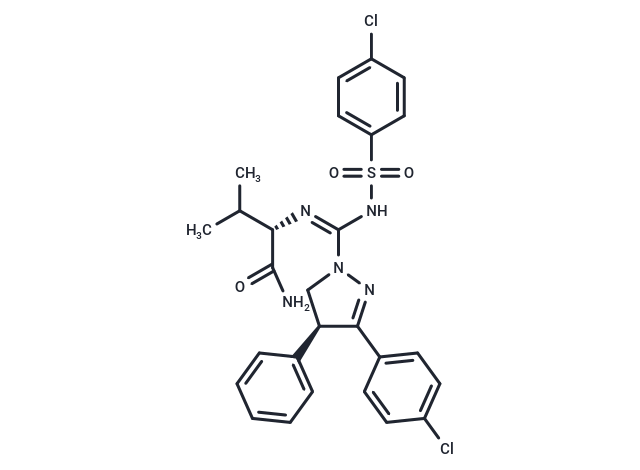Shopping Cart
- Remove All
 Your shopping cart is currently empty
Your shopping cart is currently empty

JD-5037 is a novel, peripherally restricted CB1R antagonist with an IC50 of 1.5 nM.

| Pack Size | Price | Availability | Quantity |
|---|---|---|---|
| 1 mg | $37 | In Stock | |
| 2 mg | $53 | In Stock | |
| 5 mg | $87 | In Stock | |
| 10 mg | $143 | In Stock | |
| 25 mg | $259 | In Stock | |
| 50 mg | $389 | In Stock | |
| 100 mg | $579 | In Stock | |
| 1 mL x 10 mM (in DMSO) | $108 | In Stock |
| Description | JD-5037 is a novel, peripherally restricted CB1R antagonist with an IC50 of 1.5 nM. |
| Targets&IC50 | CB1 receptor:1.5 nM |
| In vivo | JD5037, when administered at a dosage of 3 mg/kg/day intraperitoneally (i.p.), effectively induces uniform reductions in body weight and mitigates high-fat diet (HFD)-induced hyperglycemia, hepatic injury, and steatosis in obese Magel2-null mice. Likewise, oral administration of JD5037 (3 mg/kg/day, p.o.) significantly diminishes tumor size and eliminates tumors in DEN-treated mice. Moreover, JD5037 reduces anandamide (AEA) levels in hepatocellular carcinoma (HCC) samples from mice. |
| Animal Research | Mice: JD-5037 is formulated in vehicle (V; 1% Tween80, 4% DMSO, 95% Saline). Obese mice are treated chronically (28 d) with vehicle (V; 1% Tween80, 4% DMSO, 95% Saline), JD5037, or SLV319 at a dose of 3 mg/kg, i.p. Body weight and food intake are monitored daily. Mice are euthanized by cervical dislocation under anesthesia; the brain, hypothalamus, liver, and combined fat pads are removed, weighed, and snap-frozen, and trunk blood is collected for determining the endocrine and biochemical parameters |
| Alias | JD 5037 |
| Molecular Weight | 572.51 |
| Formula | C27H27Cl2N5O3S |
| Cas No. | 1392116-14-1 |
| Smiles | CC(C)[C@H](\N=C(\NS(=O)(=O)c1ccc(Cl)cc1)N1C[C@@H](C(=N1)c1ccc(Cl)cc1)c1ccccc1)C(N)=O |
| Relative Density. | 1.40 g/cm3 (Predicted) |
| Storage | Powder: -20°C for 3 years | In solvent: -80°C for 1 year | Shipping with blue ice. | ||||||||||||||||||||||||||||||
| Solubility Information | DMSO: 50 mg/mL (87.33 mM), Sonication is recommended. | ||||||||||||||||||||||||||||||
Solution Preparation Table | |||||||||||||||||||||||||||||||
DMSO
| |||||||||||||||||||||||||||||||

Copyright © 2015-2025 TargetMol Chemicals Inc. All Rights Reserved.